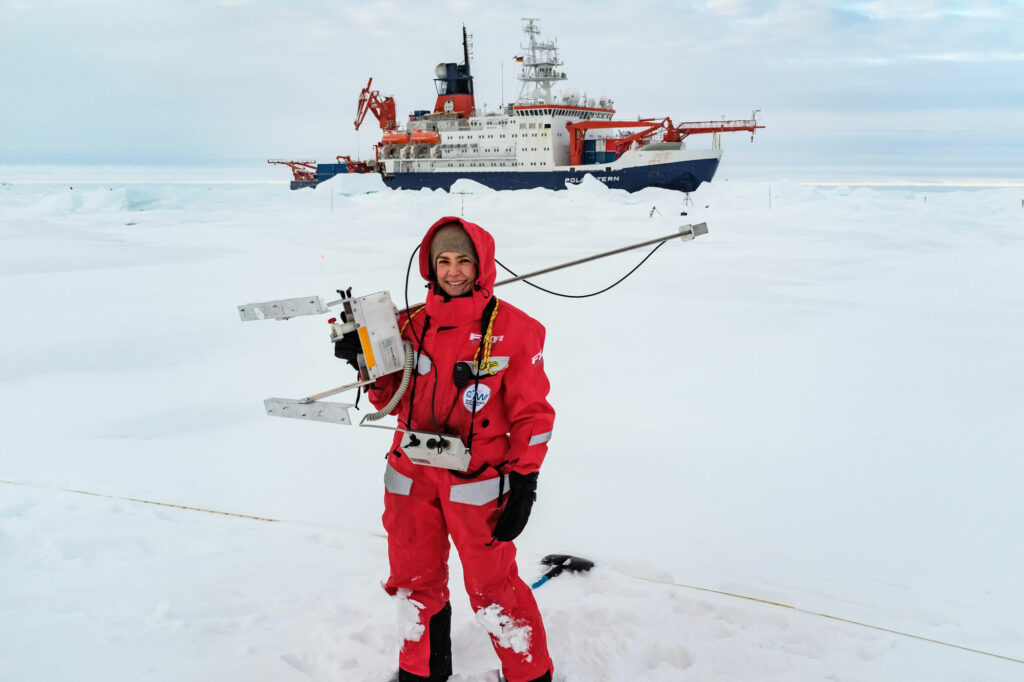The research vessel “Polarstern” returned from the Arctic on 12 October 2020. Ruzica Dadic was part of the last leg of the MOSAiC expedition. In this logbook entry, she regales us with tales of polar bears, sledges and more.
Wellington, New Zealand, 15 July 2020, 4.30 a.m.: Today marks the start of the MOSAiC expedition for me. In a panic that I’ll forget something, I wake early and decide to pack a few more balls of wool in case I get bored during my time on the “Polarstern”. In a few hours’ time, I’ll have to say goodbye to my three children for three-and-a-half months, and my stomach is turning somersaults.
…Fast forward to 12 August: After a 36-hour flight, two weeks of quarantine in Bremerhaven and two weeks on board the Russian icebreaker Akademik Tryoshnikov, we finally catch sight of the Polarstern. After another three days spent to-ing and fro-ing between the two ships, during which Amy (who is returning home after two MOSAiC stints) and I can swap information, the time finally comes to head to our new ice floe.
…Fast forward to 20 August: Following a short detour to the North Pole, we wake up one morning to find ourselves on a new floe. But lo and behold: there’s no snow to be seen! There is some white stuff that looks like snow and feels like snow, but in fact this is what’s known as the “litter layer”, consisting of melted sea ice from which the brine has already leached away. Not letting this put us off, we are keen to get down to the snow measurements right away.

But there’s another small problem:
How do we pack our mountain of snow instruments onto one sledge?
Since I don’t always have someone to help me with the measurements, taking more than one sledge is not really practical. Fortunately, our colleagues from Colorado have lent us one of their large sledges and we’re all set to start work. Or at least we think we are. In fact, packing up the snow-profile sledge for the first time requires a bit of creative thinking, as even with a large sledge there is still a lot to get on.

But, being smart snow scientists, we soon found what was surely the only possible way to accommodate all the gear we needed on the sledge. We then spent weeks measuring snow profiles, until one day a polar bear suddenly came charging towards us and the whistle sounded summoning us all back to the ship. We didn’t have time to go through the rigmarole of packing up the sledge so had to leave it on the ice floe. We then watched from the ship as the polar bear sniffed about among the snow instruments with great interest. We were terrified that it would devour our high-precision measuring equipment or even the valuable data we’d been collecting.
Polar bears get bored too
But luckily for us (through not so luckily for our colleague), an automatic weather station soon aroused the bear’s curiosity and he wandered off to play with the funny-looking wind-measuring devices. Eventually, after thoroughly inspecting every single instrument on our ice floe, he got bored and moved on. We were then able to bring our sledge (fortunately intact) back onto the ship.
We were to receive several more visits from polar bears, and had to suspend our measurements on a number of occasions. But in the end we managed to collect enough decent snow measurements, and have some exciting adventures along the way. Now we are on our way back to Bremerhaven, MOSAiC is over and we are ready for the next “adventure”: evaluating the data. Our measurements are important pieces of the jigsaw that will enable us to better understand the role of snow on sea ice and so give us more of an insight into the climate of the polar regions. And that’s good news not just for us, but also for the polar bears.

Dr. Ruzica Dadic is a Senior Research Fellow at the Victoria University of Wellington. This field note relates to her participation in leg 5 of the MOSAiC expedition as part of the project team SnowMOSAiC co-funded by the Swiss Polar Institute.
The SnowMOSAiC team has posted more information on its participation in the MOSAiC expedition on a dedicated blog.
Header photograph: Mario Hoppmann
© All rights reserved, Ruzica Dadic 2025

